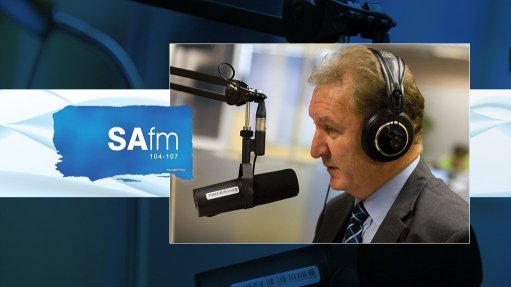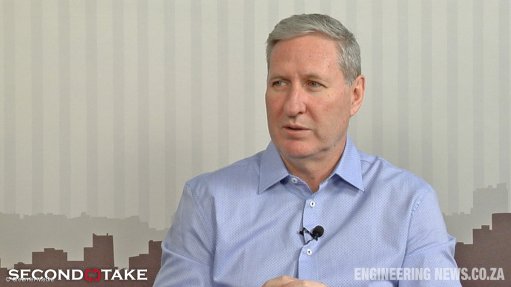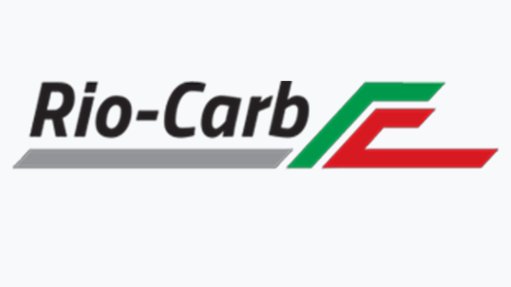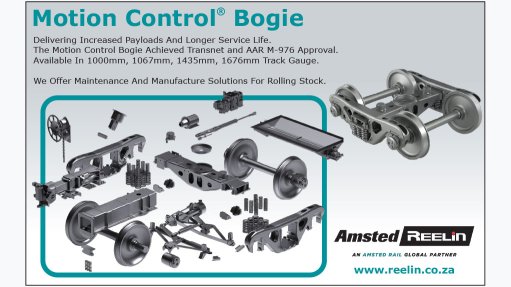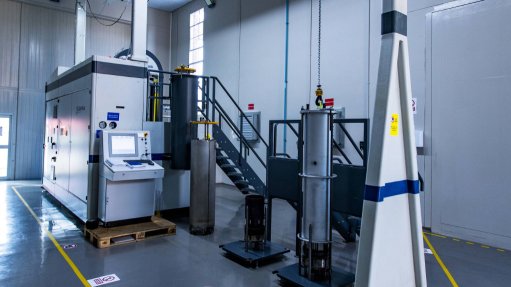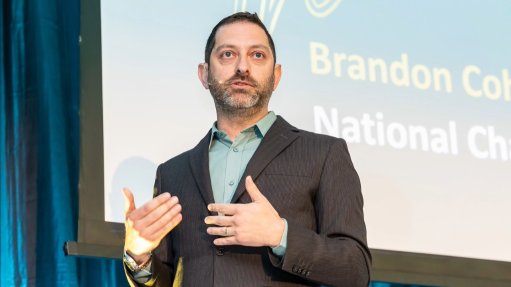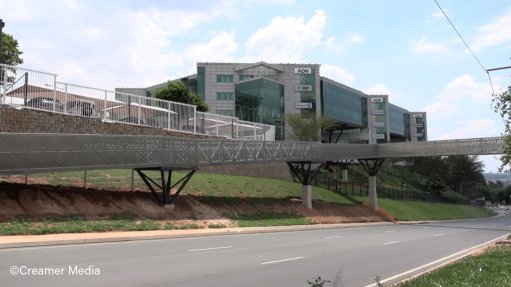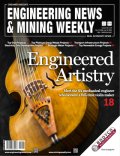Tau outlines govt response to automotive sector challenges

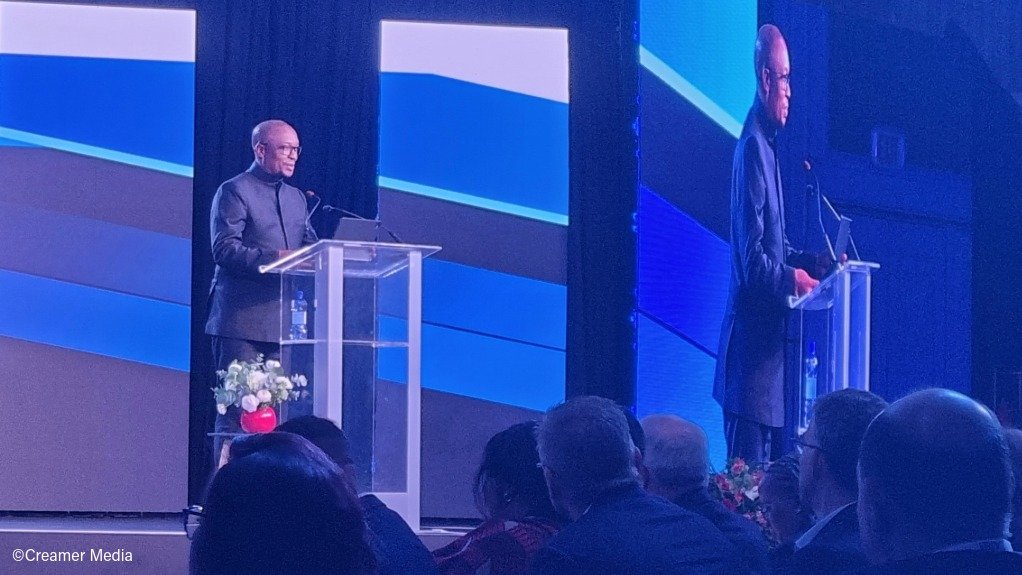
Trade, Industry and Competition Minister addressing delegates at NAACAM's 2025 show
Photo by Creamer Media's Marleny Arnoldi
Trade, Industry and Competition Minister Parks Tau has said the National Association of Automotive Component and Allied Manufacturers (NAACAM) is hosting its 2025 Show, in Gqeberha, at a defining moment for South Africa’s automotive sector.
During a keynote address on the opening day of the event on August 13, Tau pointed out that the automotive component sector, which accounted for 22.6% of South Africa’s industrial output and 5.2% of GDP, demanded urgent collaboration to preserve this contribution.
While global trade turmoil and geopolitical tensions had created uncertainty for automotive component and vehicle manufacturers, Tau pointed out there were opportunities to redefine South Africa's competitiveness.
Accordingly, he urged all stakeholders to join in unified action for increased localisation, innovation and inclusive transformation, especially as local production and sales of vehicles had experienced challenges, notably the imposition of US import tariffs of late.
Domestic sales of locally produced vehicles decreased to 515 850 units in 2024, which is far below the South Africa Automotive Masterplan (SAAM) 2035 target of 784 509 units. Notably, 64% of vehicles sold in South Africa were imports, which eroded local production sales.
Compounding this, local content remained stagnant at 39%, which was well short of the 60% local content target envisioned in the SAAM. Tau said these pressures had triggered 12 company closures and more than 4 000 job losses in the past two years.
The erosion of industrial value of the automotive sector is exemplified by the recent temporary suspension of operations at Mercedes-Benz, which has since resumed operations, and the announced closure of tyre producer Goodyear.
Tau believes a 5% increase in local content could unlock R30-billion in new procurement, which could dwarf the R4.4-billion US market for South Africa’s exports.
He mentioned that, to help address some of the bottlenecks to growth, government was viewing the Automotive Production Development Programme (APDP) as a comprehensive way of responding to the challenges the sector was facing, as well as to ensure growth in the sector to meet the goals of the SAAM.
Proposed amendments to the APDP include a legislative framework for electric vehicles (EVs) and associated components, with relevant amendments also being made to the Automotive Investment Scheme and Taxation Laws Amendment Act to introduce a 150% capital allowance for qualifying investments in EV and hydrogen vehicle production. It covers assets such as buildings, plant and equipment brought into use between March 1, 2026 and March 1, 2036.
Some of the other planned reforms include the incentive structure and shifting duty credits to reward manufacturing instead of assembly credits, while a Critical Minerals Strategy and Battery Value Chain Master Plan are being developed to built regional supply chain capacity.
“Global competitiveness hinges on embracing disruption. At the Department of Trade, Industry and Competition (dtic), we have been engaged on a path of developing a new industrial policy that focuses on decarbonisation, digitisation and diversification,” Tau stated.
He cited examples such as component manufacturers Jendamark and S4 having demonstrated how technological capabilities such as AI and automation can future-proof operations and ensure efficiency.
Tau recognises that carbon has become part of the cost of doing business and, increasingly, part of the value too.
“We must scale new products such as e-axles and thermal systems, as well as markets, particularly under the African Continental Free Trade Area.”
Moreover, the dtic is assisting with the development of EV skills curricula and certification programmes with various universities, to cater for the new skills that are necessary in an EV production environment.
The department also plans to introduce an Omnibus Bill, or General Laws Amendment, which looks to fast-track high-impact investments and projects to within 90 days. This is, however, a more ambitious plan for the medium term.
“We will also look at the impact of imports into the country through the International Trade Administration Commission. We want to grow the sector; our first option must not be to wield a stick, but rather to attract more investment into the country and increase value-add of component manufacturing,” Tau stated.
All of these efforts showed how government was working hard to eliminate compliance burdens and reduce red tape that inhibited investment in the country’s automotive sector, as well as government’s efforts to ensure a future-ready workforce, Tau added.
He concluded by encouraging industry to continue honouring local procurement targets and investing in smaller businesses. “Tier 1 suppliers must drive equity partnerships and Tier 2 and 3 supplier development initiatives.
“The Eastern Cape epitomises our potential – since it procures 46% of South Africa’s vehicles – and it is incumbent on all of us to reignite the collective ambition that drives NAACAM’s advocacy for African industrial resilience rooted in localisation.”
CONCURRING VIEW
Employment and Labour Minister Nomakhosazana Meth, meanwhile, told delegates at the NAACAM Show that although many of the challenges in the local automotive sector were not of its own making, there was a collective responsibility to shape a new path to revitalise industries and compete in a changing global economy.
She said that, without meaningful government and industry intervention, the manufacturing base would continue to erode and threaten thousands of livelihoods that had become dependent on automotive manufacturing companies.
A major concern for her had been ArcelorMittal South Africa announcing the closure of its long steel business, which Meth said was the backbone of the automotive industry, having produced 70 000 t/y of long steel that will now have to be imported at higher costs.
“We need a Steel Master Plan anchored in private-public partnerships,” she said, citing more opportunities for sector upliftment as a focus on tailoring models for the sub-Saharan Africa market, scaling hybrid vehicles supplies to Asia and scaling battery component production for the EU.
Meth said calls for protection and preservation of South Africa’s industrial capacity had never been louder and while government and industry could not control the tides of global dynamics, it could control how it responded and adapted.
Eastern Cape Economic Development, Environmental Affairs and Tourism MEC Nonkqubela Pieters emphasised the importance of mutually beneficial strategies and models at a provincial and national level to the global challenges presented to the automotive industry.
“Sustainable growth can only be realised through a collaborative approach that enhances our localisation value proposition. Targeted, structural support is necessary, including in network industries such as logistics, to sustain the critical industry that is automotive component manufacturing,” she explained.
Pieters confirmed that the Eastern Cape government had been focused on pragmatic solutions to support the automotive industry, including by advancing renewable-energy initiatives to ensure reliable electricity supply and devising an Eastern Cape Hydrogen Strategy.
Article Enquiry
Email Article
Save Article
Feedback
To advertise email advertising@creamermedia.co.za or click here
Comments
Press Office
Announcements
What's On
Subscribe to improve your user experience...
Option 1 (equivalent of R125 a month):
Receive a weekly copy of Creamer Media's Engineering News & Mining Weekly magazine
(print copy for those in South Africa and e-magazine for those outside of South Africa)
Receive daily email newsletters
Access to full search results
Access archive of magazine back copies
Access to Projects in Progress
Access to ONE Research Report of your choice in PDF format
Option 2 (equivalent of R375 a month):
All benefits from Option 1
PLUS
Access to Creamer Media's Research Channel Africa for ALL Research Reports, in PDF format, on various industrial and mining sectors
including Electricity; Water; Energy Transition; Hydrogen; Roads, Rail and Ports; Coal; Gold; Platinum; Battery Metals; etc.
Already a subscriber?
Forgotten your password?
Receive weekly copy of Creamer Media's Engineering News & Mining Weekly magazine (print copy for those in South Africa and e-magazine for those outside of South Africa)
➕
Recieve daily email newsletters
➕
Access to full search results
➕
Access archive of magazine back copies
➕
Access to Projects in Progress
➕
Access to ONE Research Report of your choice in PDF format
RESEARCH CHANNEL AFRICA
R4500 (equivalent of R375 a month)
SUBSCRIBEAll benefits from Option 1
➕
Access to Creamer Media's Research Channel Africa for ALL Research Reports on various industrial and mining sectors, in PDF format, including on:
Electricity
➕
Water
➕
Energy Transition
➕
Hydrogen
➕
Roads, Rail and Ports
➕
Coal
➕
Gold
➕
Platinum
➕
Battery Metals
➕
etc.
Receive all benefits from Option 1 or Option 2 delivered to numerous people at your company
➕
Multiple User names and Passwords for simultaneous log-ins
➕
Intranet integration access to all in your organisation







